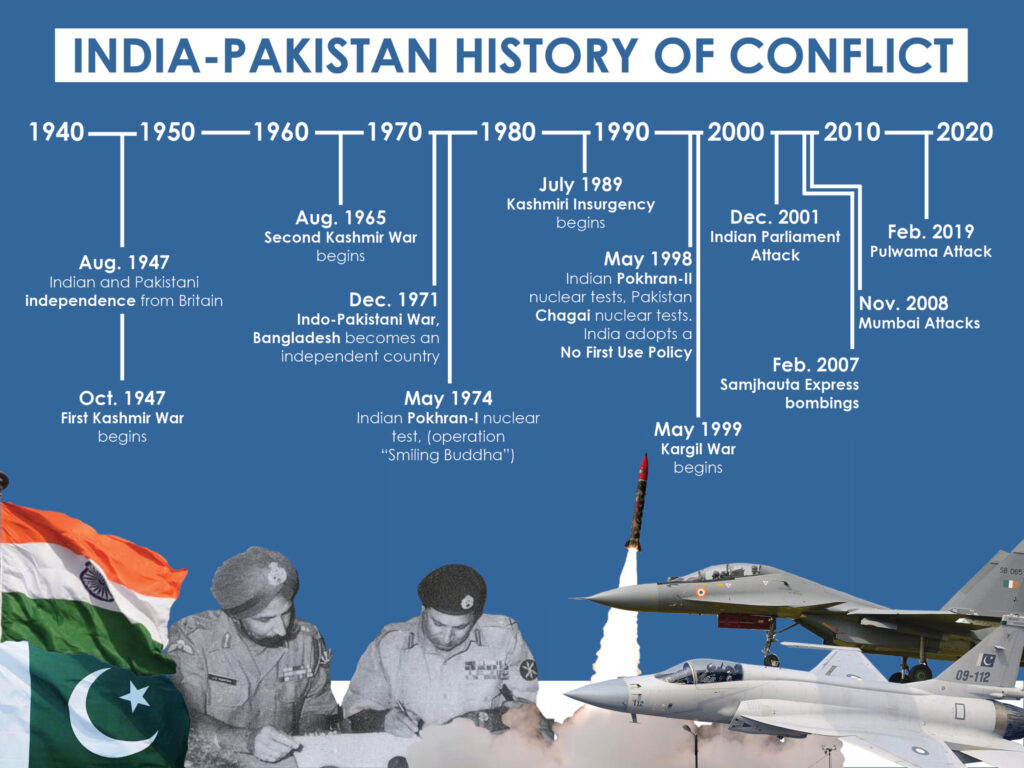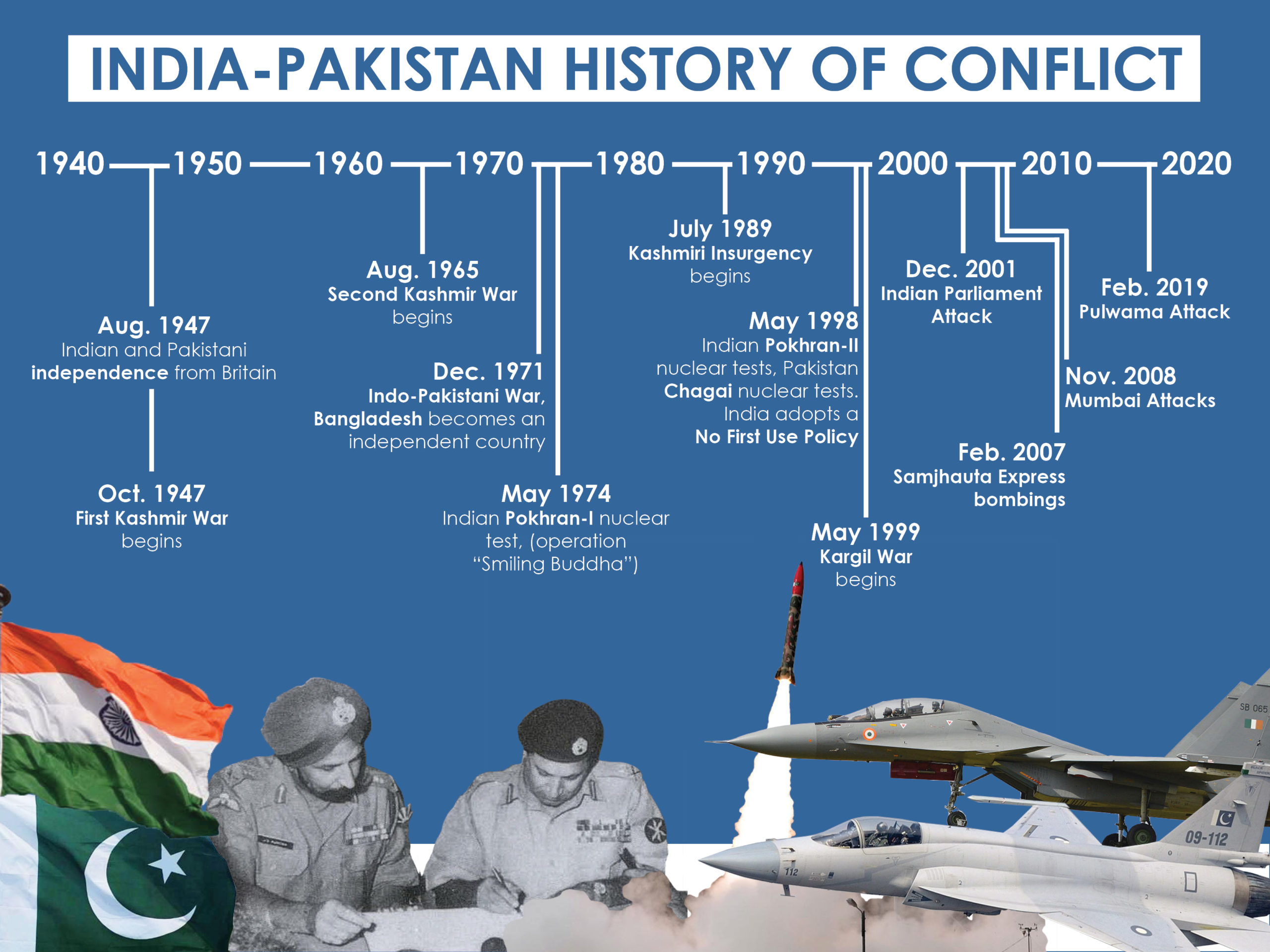The India-Pakistan wars are a series of conflicts between two neighboring nations, India and Pakistan, which have occurred since their partition in 1947. These wars have been shaped by complex historical, political, and territorial disputes, and they form a significant part of the modern history of South Asia. Here, we provide a detailed account of each major conflict, along with its historical context.

The India-Pakistan Wars: A Comprehensive Historical Overview
1. First Indo-Pak War (1947-48): The First Indo-Pak War, also known as the First Kashmir War, erupted immediately after the partition of British India into two independent states, India and Pakistan, on August 15, 1947. The partition marked the end of British colonial rule but led to significant challenges, particularly regarding the princely state of Jammu and Kashmir. Maharaja Hari Singh, the ruler of Kashmir, faced a difficult decision – whether to accede to India, Pakistan, or remain independent.
The war began when tribal militias, supported by Pakistan, entered Kashmir to claim the territory. This aggression led to a full-scale conflict between India and Pakistan. The conflict eventually drew the attention of the United Nations, resulting in a ceasefire agreement and the establishment of the Line of Control (LoC) in 1948, which demarcated the territories of India and Pakistan in the region.
- Casualties: The exact number of casualties during the First Indo-Pak War is a subject of debate and varies among sources. Estimates suggest that thousands of soldiers and civilians were killed.
- Surrender: The war led to the first-ever ceasefire and the establishment of the Line of Control (LoC) in 1948. There were instances of surrenders during the conflict, but specific numbers are not widely documented.
The ceasefire has remained tenuous, and the Kashmir issue continues to be a significant source of tension and conflict between the two nations.
2. Second Indo-Pak War (1965): The Second Indo-Pak War, often referred to as the Second Kashmir War, occurred between India and Pakistan in April 1965. The war was primarily triggered by territorial disputes in the Rann of Kutch, a region in western India. However, the conflict quickly escalated to the Kashmir region, which had been a long-standing source of tension between the two nations.
The conflict led to a ceasefire in 1965, following international mediation, particularly by the Soviet Union and the United States. Despite no significant territorial changes, the war underscored the need for a more permanent resolution to the Kashmir issue.
- Casualties: In the Second Indo-Pak War, both India and Pakistan suffered heavy casualties. Estimates of military casualties range from 3,000 to 3,500 for India and 5,800 to 9,000 for Pakistan. Civilian casualties were also significant.
- Surrender: There were cases of soldiers from both sides taken as prisoners of war (POWs), although a specific number of surrenders is not well-documented.
3. Third Indo-Pak War (1971): The Third Indo-Pak War, often considered the most significant conflict between India and Pakistan, was a result of the Bangladesh Liberation War. The conflict was sparked when East Pakistan (now Bangladesh) sought independence from West Pakistan (present-day Pakistan), igniting a brutal and bloody struggle.
India supported the Bangladeshi struggle for independence, which led to a full-scale war between India and Pakistan. The war included widespread atrocities, including the killing and displacement of countless civilians. The conflict culminated in the surrender of Pakistani forces in Dhaka, which led to the creation of Bangladesh as an independent nation on December 16, 1971.
- Casualties: The Third Indo-Pak War (1971) was particularly brutal and resulted in substantial casualties. Estimates suggest that thousands of soldiers and civilians were killed during the conflict. The majority of casualties were on the Pakistani side.
- Surrender: One of the most notable surrenders in military history occurred in Dhaka, Bangladesh, on December 16, 1971, when Pakistani forces, under the command of Lieutenant General A. A. K. Niazi and 93000 soldiers, surrendered to the joint Indian and Bangladeshi forces.
4. Kargil War (1999): The Kargil War, also known as the Kargil Conflict, was a limited conflict that occurred in the Kargil district of Jammu and Kashmir in 1999. The conflict began when Pakistani soldiers and militants infiltrated into Indian territory, specifically in the Kargil sector. This event marked a significant escalation in hostilities between India and Pakistan.
The war lasted for approximately two months and ended with India regaining control of the territory after a series of intense battles and international diplomatic efforts.
- Casualties: The Kargil War resulted in casualties on both sides. India reported over 500 soldiers killed, while Pakistan did not officially disclose its casualty figures.
- Surrender: There were instances of Pakistani soldiers being captured by Indian forces during the conflict, but the number of surrenders was relatively low.
5. Siachen Conflict (1984-Present): The Siachen Conflict is an ongoing and often overlooked territorial dispute that began in 1984. The conflict revolves around the Siachen Glacier region, located in the northern part of the Kashmir region. Both India and Pakistan maintain military posts at incredibly high altitudes in the region, making it one of the most inhospitable and challenging battlefields in the world.
The Siachen Glacier region is characterized by harsh weather conditions, avalanches, and extreme altitudes. The prolonged conflict has resulted in numerous casualties and logistical challenges for both sides. Despite several ceasefire agreements and negotiations, a permanent resolution has remained elusive.
- Casualties: The Siachen Conflict has seen casualties primarily due to extreme weather conditions, avalanches, and frostbite. Specific figures are not readily available but are estimated to be in the hundreds on both sides.
- Surrender: Surrenders in the Siachen Conflict are less common compared to traditional wars. The main challenges in this high-altitude conflict are related to the environment and logistics.
These are the major wars and conflicts between India and Pakistan, each marked by its unique historical context, complexities, and consequences. These wars have not only shaped the geopolitical landscape of South Asia but have also left lasting scars on the collective memory of the region. For those seeking a deeper understanding of these conflicts, historical accounts, academic sources, books, and documentaries on this topic offer comprehensive insights into the intricate dynamics of the India-Pakistan wars.
Follow our Facebook Page Click Here
Share our website Click Here
